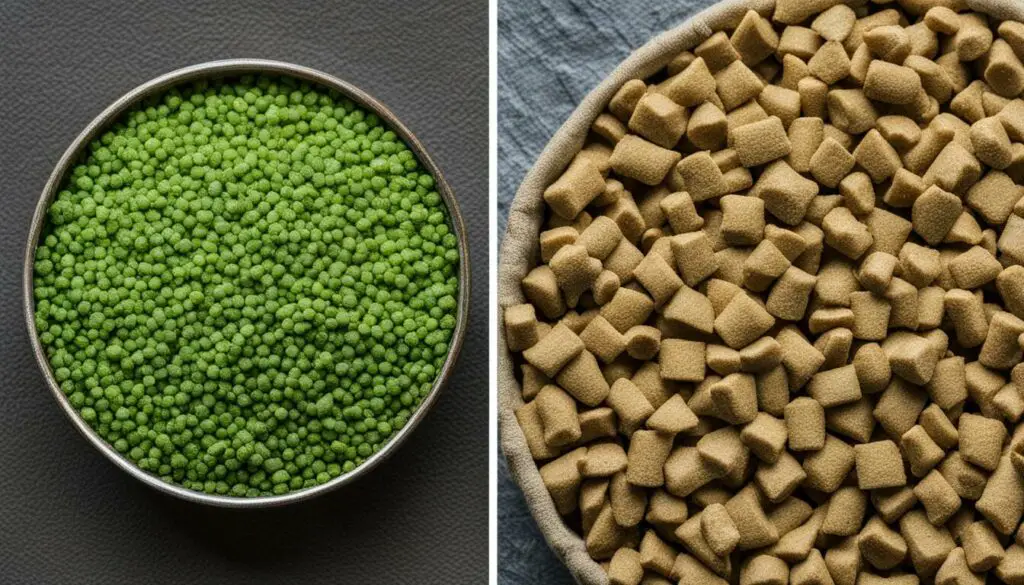When it comes to choosing the right litter for your rabbit, it’s important to consider their health and comfort. While cat litter and pine pellets are popular options, there are important factors to consider before making a decision. Let’s explore the pros and cons of each option and determine which is best for your furry friend.
Key Takeaways:
- Consider your rabbit’s health and safety when choosing litter
- Cat litter is not recommended due to clumping and ingestion risks
- Pine pellets provide good absorbency and odor control
- Safe litter options for rabbits include paper-based pellets and aspen shavings
- Regular cleaning of the litter box is essential for maintaining hygiene
The Dangers of Pine and Cedar Shavings for Rabbits
When it comes to choosing the right litter for your rabbit, it’s important to prioritize their health and well-being. Unfortunately, pine and cedar shavings are not suitable options for rabbit bedding. These types of wood contain aromatic oils that can be harmful to a rabbit’s liver and respiratory system.
The aromatic oils found in pine and cedar shavings can release toxic fumes when they come into contact with moisture, such as urine. This can lead to respiratory issues for your rabbit, including respiratory infections and difficulty breathing. Ingesting the shavings can also have negative effects on their liver health.
To ensure the safety of your furry friend, it’s best to avoid using pine and cedar shavings as litter for your rabbit. Instead, opt for safer alternatives such as paper-based pellets, aspen shavings, or compressed sawdust pellets. These options provide a healthier and more comfortable environment for your rabbit while minimizing the risk of respiratory and liver problems.
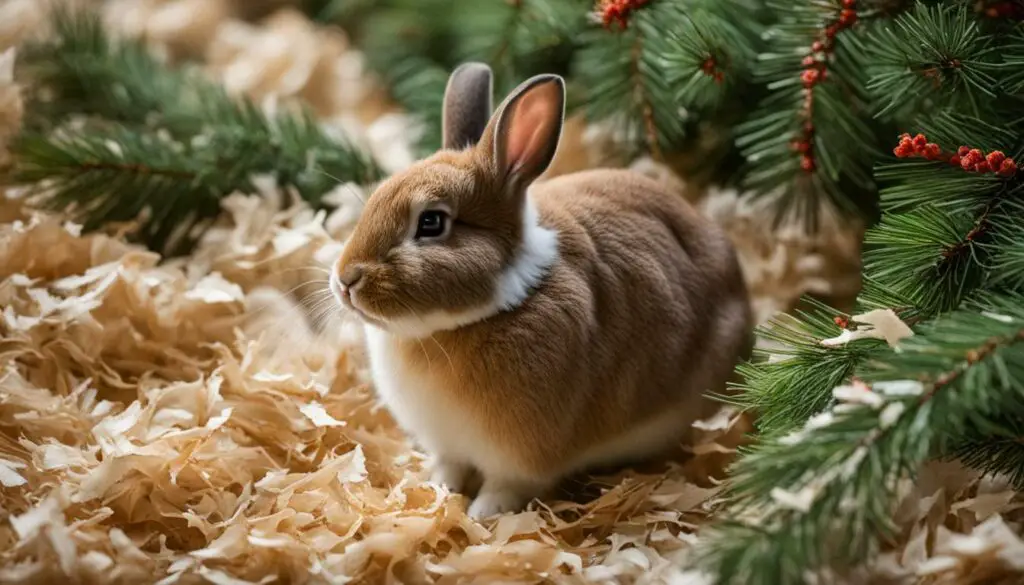
Table: Alternatives to Pine and Cedar Shavings for Rabbit Litter
| Litter Option | Pros | Cons |
|---|---|---|
| Paper-based pellets | Low dust, good absorbency, safe for ingestion | May need frequent changing |
| Aspen shavings | Low dust, good absorbency, safe for ingestion | May be more expensive |
| Compressed sawdust pellets | Low dust, good absorbency, safe for ingestion | May break down quickly and need frequent changing |
By choosing a safe and suitable litter for your rabbit, you can ensure their comfort and reduce the risk of health issues associated with pine and cedar shavings. Always prioritize their well-being and provide them with a clean and healthy environment to thrive in.
Recommended Litter Options for Rabbits
When it comes to choosing the right litter for your rabbit, there are several safe and suitable options available. Let’s explore some recommended litters that offer various benefits for your furry friend.
1. Newspaper: Recycled newspaper pellets or shredded newspaper can be a cost-effective and environmentally-friendly option. They are low dust and provide good absorbency for odor control.
2. Paper Pulp Litter: Made from recycled paper, paper pulp litter is highly absorbent and has excellent odor control. It is also safe for rabbits to ingest if they nibble on it.
3. Oat, Alfalfa, and Wheat Straw Pellets: These natural and biodegradable pellets offer good absorbency and odor control. They are safe for rabbits and provide a comfortable bedding option.
4. Compressed Sawdust Pellets: These compressed pellets are made from wood shavings and provide good absorbency. They are low dust and can be a convenient choice for rabbit owners.
5. Aspen Bark or Shredded: Aspen bedding is a safe and comfortable option for rabbits. It provides good absorbency and is free of aromatic oils that can be harmful to their health.
6. Straw or Hay: Straw or hay can also be used as litter for rabbits, especially in litter boxes where they tend to nibble and rest. It provides a natural and familiar bedding option for rabbits.
| Litter Option | Benefits |
|---|---|
| Newspaper | Low dust, good absorbency, and odor control |
| Paper Pulp Litter | Highly absorbent, excellent odor control, safe to ingest |
| Oat, Alfalfa, and Wheat Straw Pellets | Natural, biodegradable, good absorbency and odor control |
| Compressed Sawdust Pellets | Low dust, convenient, good absorbency |
| Aspen Bark or Shredded | Safe, comfortable, good absorbency |
| Straw or Hay | Natural bedding, familiar to rabbits |
These recommended litter options offer a range of benefits such as low dust, good absorbency, odor control, and safety for rabbits to ingest if they nibble on them. Consider your rabbit’s specific needs and preferences when selecting the right litter for their comfort and overall well-being.
Pros and Cons of Cat Litter for Rabbits
When considering cat litter as an option for rabbit litter, it’s important to weigh the pros and cons to make an informed decision that prioritizes your rabbit’s health and well-being. While cat litter may seem like a convenient choice, it is generally not recommended for rabbits due to certain drawbacks.
One of the main concerns with using cat litter for rabbits is the clumping properties of most cat litters. Rabbits have a tendency to nibble on their litter, and if they ingest clumping cat litter, it can potentially cause blockages in their digestive system, leading to serious health issues. Therefore, it’s essential to avoid clumping cat litters when considering them for your rabbit.
However, it’s worth noting that there are some cat litters available on the market that are made from paper and are safe for rabbits. These paper-based cat litters do not clump and pose a lower risk of blockages if ingested. It is important to carefully read the labels and choose a cat litter that is specifically designed for rabbits or small animals.
| Pros of Cat Litter for Rabbits | Cons of Cat Litter for Rabbits |
|---|---|
| Provides good absorbency | Potential ingestion risks |
| Offers odor control | Clumping properties can cause blockages |
| Convenient and easily accessible | Not suitable for all rabbits |
It’s important to remember that every rabbit is unique, and what works well for one rabbit may not work for another. If you decide to use cat litter for your rabbit, closely monitor their behavior and health to ensure that there are no adverse effects. Always consult with a veterinarian if you have any concerns or questions about the suitability of cat litter for your rabbit.
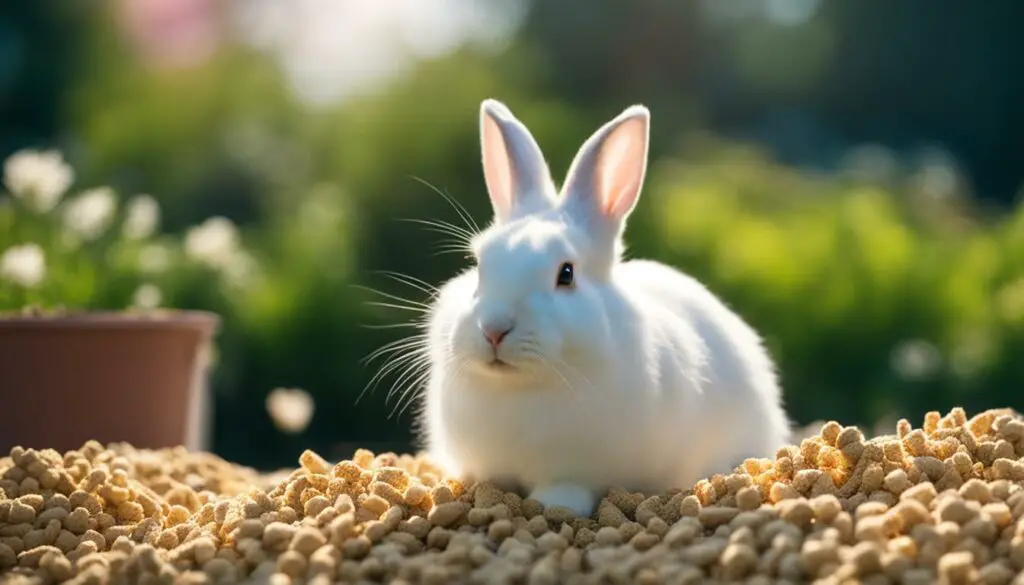
The Benefits of Pine Pellets for Rabbits
When it comes to choosing the right litter for your rabbit, there are several options to consider. One of these options is pine pellets, which offer numerous benefits for both you and your furry friend. Pine pellets are highly absorbent, making them excellent at controlling odors and keeping your rabbit’s living space clean and fresh. Unlike pine shavings, pine pellets do not contain harmful aromatic oils that can be detrimental to your rabbit’s health.
In addition to their absorbency and odor control properties, pine pellets are also an eco-friendly choice. They can be composted, reducing waste and benefiting the environment. Pine pellets are also a cost-effective option, as they are often more affordable than other types of litter. Furthermore, they are lightweight and easy to handle, making them convenient for both you and your rabbit.
“Pine pellets are highly absorbent, making them excellent at controlling odors and keeping your rabbit’s living space clean and fresh.”
It’s important to note that while pine pellets are generally safe for rabbits, individual sensitivities may vary. Some rabbits may develop allergies or respiratory issues when exposed to pine. Therefore, it’s crucial to monitor your rabbit’s health and behavior when introducing any new litter. If you notice any signs of discomfort or adverse reactions, it’s best to consult with a veterinarian.
| Benefits of Pine Pellets for Rabbits |
|---|
| High absorbency |
| Effective odor control |
| Eco-friendly and compostable |
| Affordable |
| Lightweight and easy to handle |
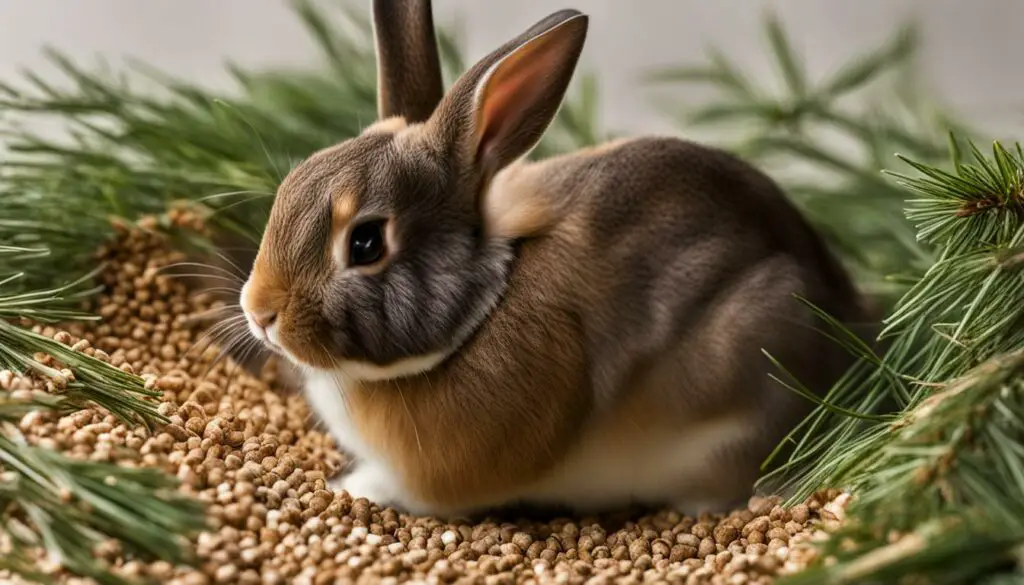
Conclusion
Pine pellets can be a beneficial choice for rabbit litter due to their absorbency, odor control properties, and eco-friendliness. However, it’s important to prioritize your rabbit’s health and monitor their well-being when introducing any new litter. Whether you choose pine pellets or another type of litter, always ensure that it is safe, comfortable, and conducive to your rabbit’s overall well-being.
Considerations When Choosing Between Cat Litter or Pine Pellets
When it comes to choosing between cat litter and pine pellets for your rabbit, there are several important considerations to keep in mind. The litter choice you make can have a significant impact on your rabbit’s health, safety, and overall comfort. By carefully evaluating the pros and cons of each option, you can make an informed decision that meets your rabbit’s needs.
1. Rabbit Health: The primary concern when selecting litter is the impact it may have on your rabbit’s health. Some cat litters can clump when wet, leading to potential blockages if ingested by your rabbit. On the other hand, pine pellets do not clump and are generally safe for rabbits. It’s crucial to choose a litter that minimizes any risks to your rabbit’s digestive system.
2. Safety: Safety is another vital consideration when choosing litter for your rabbit. Cat litters may contain chemicals or additives that can be harmful if ingested or inhaled by your rabbit. Pine pellets, on the other hand, are typically free of harmful substances and are a safe option. Prioritize a litter that poses no risks to your rabbit’s well-being.
3. Rabbit Comfort: Your rabbit’s comfort should also be taken into account. Some rabbits may have preferences for certain types of litter, while others may be more adaptable. Consider your rabbit’s habits and behaviors when choosing a litter that they will find comfortable to use. Providing a litter that encourages natural digging and burrowing instincts can enhance your rabbit’s overall well-being.
| Considerations | Cat Litter | Pine Pellets |
|---|---|---|
| Rabbit Health | Possible ingestion risks and clumping | Generally safe and non-clumping |
| Safety | Possible chemicals or additives | Typically free of harmful substances |
| Rabbit Comfort | May vary depending on rabbit’s preferences | Generally comfortable and adaptable |
By carefully considering the health, safety, and comfort of your rabbit, you can make an informed decision when choosing between cat litter and pine pellets. Prioritize a litter that minimizes health risks, ensures safety, and promotes your rabbit’s well-being. Observing your rabbit’s behavior and preferences will also guide you in selecting the most comfortable litter option for them. Remember, your rabbit’s litter choice plays a significant role in their overall care and happiness.
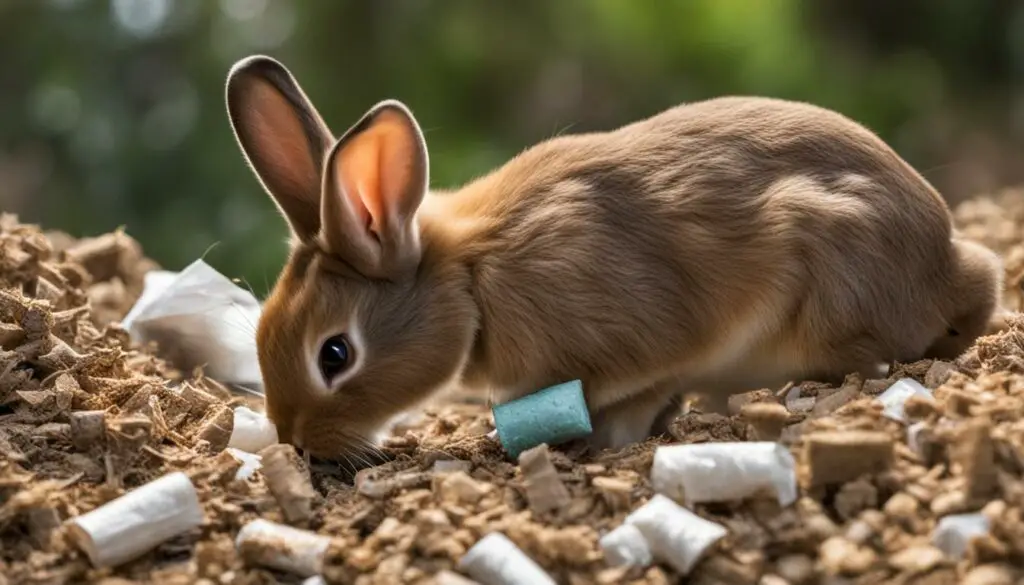
How Much Litter to Use in a Rabbit Litter Box
When it comes to determining the right amount of litter to use in a rabbit litter box, there are a few factors to consider. The size of the litter box and the absorbency of the litter play a role in determining the appropriate amount. Generally, a layer of litter that is about half an inch thick is sufficient to absorb urine and prevent strong odors.
It’s important to note that larger rabbits may require more litter due to their increased urine output. If you have a larger breed or a rabbit that tends to produce more urine, you may need to add a bit more litter to ensure effective absorption.
Remember, it’s essential to monitor the litter box regularly and adjust the amount of litter as needed. If you notice that the litter is becoming saturated quickly or that odor control is not optimal, you may need to add more litter to maintain a clean and odor-free environment for your rabbit. On the other hand, if you’re consistently finding that a small amount of litter is sufficient, there’s no need to overfill the litter box.
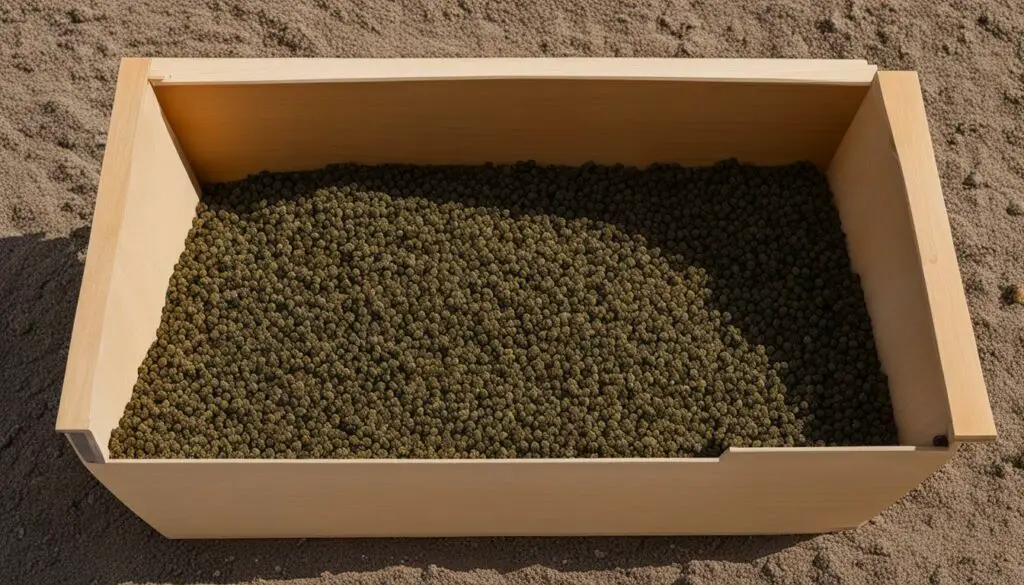
Keep in mind that rabbits have a natural instinct to dig and burrow, so be mindful of providing enough litter for them to engage in these natural behaviors. However, excessive amounts of litter may lead to unnecessary waste and make cleaning the litter box more challenging.
The Importance of Including Hay in the Litter Box
When it comes to litter training rabbits, including hay in the litter box can make a big difference. Rabbits naturally have a habit of munching on hay while they poop, so placing a pile of fresh hay in one end of the litter box can attract them to use it. Alternatively, you can provide a hay rack near the litter box to achieve the same effect. This simple addition can help establish good litter box habits and make the training process easier.
Including hay in the litter box has several benefits. First, it encourages rabbits to spend more time in the litter box, leading to better litter box habits and less mess outside the box. Second, it provides mental stimulation for rabbits, as they enjoy foraging for hay. This can help prevent boredom and destructive behavior. Lastly, hay has a natural odor that can cover up any smells in the litter box, making it more pleasant for both you and your rabbit.
It’s important to note that the hay in the litter box should be fresh and clean. Remove any soiled or damp hay regularly to maintain cleanliness and prevent the growth of bacteria. Additionally, consider the type of hay you use. Timothy hay is a popular choice for rabbits, as it is high in fiber and promotes good digestion. However, some rabbits may have preferences for other types of hay, such as orchard grass or alfalfa. Experiment with different types of hay to see what your rabbit prefers.
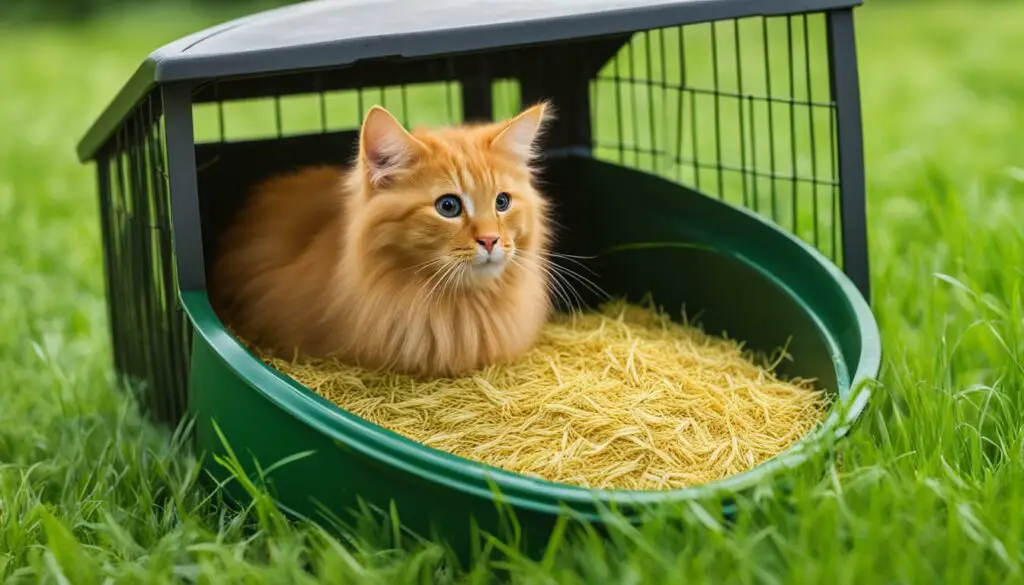
The Benefits of Including Hay in the Litter Box
- Encourages rabbits to use the litter box
- Provides mental stimulation and prevents boredom
- Natural odor helps cover up smells
- Timothy hay promotes good digestion
“Including hay in the litter box has made a noticeable improvement in my rabbit’s litter box habits. She seems to enjoy munching on the hay while using the box, and there has been a significant decrease in accidents outside the box. I highly recommend giving it a try!” – Rabbit owner
Cleaning and Maintenance of a Rabbit Litter Box
Proper cleaning and maintenance of your rabbit’s litter box are essential for maintaining their health and ensuring a clean and odor-free environment. Regular cleaning will help prevent the buildup of bacteria, eliminate strong odors, and provide a comfortable space for your furry friend. Here are some tips to help you effectively clean and maintain your rabbit’s litter box:
1. Daily Scooping and Spot Cleaning
It’s important to scoop out soiled litter and droppings from the litter box on a daily basis. This will help keep the litter box clean and prevent the accumulation of waste that can lead to odors. Spot clean any areas that have been soiled by urine or feces using a pet-safe cleaner or a mixture of vinegar and water. Regularly replacing soiled litter with fresh litter will also help maintain cleanliness.
2. Regular Deep Cleaning
In addition to daily scooping, it’s important to deep clean the entire litter box on a regular basis. This can be done by emptying the litter box completely and washing it with mild soap and water or a pet-friendly cleaner. Avoid using harsh chemicals or cleaners with strong fragrances that can be harmful to your rabbit. Allow the litter box to dry thoroughly before adding fresh litter.
3. Odor Control Techniques
To further control odors, you can sprinkle baking soda in the litter box before adding fresh litter. Baking soda helps absorb and neutralize odors, keeping the litter box smelling fresh. Alternatively, you can use pet-safe odor control products specifically made for rabbit litter boxes. These products can help extend the time between cleanings and keep odors at bay.
By following these cleaning and maintenance practices, you can ensure a clean and hygienic environment for your rabbit. Remember to monitor your rabbit’s litter box regularly and make adjustments based on their habits and preferences. A clean litter box promotes good health and hygiene, allowing your bunny to thrive and enjoy a comfortable living space.
Rabbit Litter Options: Safe and Unsafe Choices
When it comes to choosing the right litter for your rabbit, it’s crucial to prioritize their health and well-being. Some litter materials can pose potential risks to rabbits, while others are safer and more suitable for their needs. Let’s explore the safe and unsafe litter options for rabbits to help you make an informed choice for your furry friend.
Safe Litter Options for Rabbits
- Paper-based pelleted litter: These litters are made from recycled paper and are highly absorbent, making them excellent at controlling odors and maintaining cleanliness in the litter box.
- Aspen shavings: Unlike pine and cedar shavings, aspen shavings are a safe alternative that does not contain aromatic oils. They provide good absorbency and are low in dust, ensuring a comfortable environment for your rabbit.
- Compressed sawdust pelleted litter: These pellets are made from compressed sawdust, offering good absorbency and odor control. They are safe for rabbits and provide a comfortable surface for them to hop and dig in.
- Shredded paper: Another eco-friendly option, shredded paper is safe for rabbits to use as litter. It is absorbent, easy to clean, and readily available.
Unsafe Litter Options for Rabbits
- Clay litter: Clay litter can be harmful if ingested by rabbits and may cause digestive issues. It is best to avoid using clay litter in the litter box.
- Pine or cedar wood shavings: These types of shavings contain aromatic oils that can be harmful to a rabbit’s liver and respiratory system. To ensure your rabbit’s safety, it is best to steer clear of pine and cedar litter materials.
- Materials with high dust content: Litters that produce excessive dust can irritate a rabbit’s sensitive respiratory system. Avoid using litters that have a high dust content to prevent respiratory issues in your rabbit.
- Scented litters: While scented litters may mask odors, they can be overwhelming for rabbits and may cause respiratory distress. Stick to unscented litter options to keep your rabbit comfortable and healthy.
By choosing a safe litter option for your rabbit, you can create a clean and healthy environment that promotes their well-being. Remember to consider their preferences and needs when selecting a litter and regularly maintain and clean the litter box to ensure their comfort.
| Litter Type | Safety | Odor Control | Absorbency | Availability |
|---|---|---|---|---|
| Paper-based pelleted litter | Safe | Excellent | High | Readily available |
| Aspen shavings | Safe | Good | Moderate | Readily available |
| Compressed sawdust pelleted litter | Safe | Good | Good | Readily available |
| Shredded paper | Safe | Good | Moderate | Readily available |
| Clay litter | Unsafe | Poor | Moderate | Widely available |
| Pine or cedar wood shavings | Unsafe | Poor | Moderate | Widely available |
| Materials with high dust content | Unsafe | Poor | Moderate | Varies |
| Scented litters | Unsafe | Poor | Moderate | Varies |
Table: A comparison of safe and unsafe litter options for rabbits. The table highlights the safety, odor control, absorbency, and availability of each litter type to help you make an informed decision for your rabbit’s litter needs.
Considerations for Rabbit Litterbox Training
When it comes to litterbox training rabbits, there are several important considerations to keep in mind. One key factor is whether your rabbit has been spayed or neutered. Adult rabbits that have been spayed or neutered tend to be more consistent with their litterbox usage, making it easier to train them.
Starting litterbox training in a small area is another crucial step. This allows your rabbit to become familiar with the litterbox and develop positive habits. Gradually expand their territory as they get accustomed to using the litterbox, ensuring a smooth transition.
It’s important to adapt to your rabbit’s preferences and behavior during the training process. Pay attention to any signs or cues that indicate they need to use the litterbox, such as sniffing or circling. By creating a conducive environment and being patient with your rabbit, you can successfully train them to use the litterbox consistently.
Choosing the Right Litterbox and Litter for Your Rabbit
When it comes to selecting the perfect litterbox for your rabbit, there are a few key considerations to keep in mind. First and foremost, you’ll want to choose a litterbox that is the right size for your furry friend. A spacious litterbox provides ample room for your rabbit to comfortably move around and eliminates the risk of them stepping in their waste. Additionally, opting for a litterbox with higher sides can prevent litter and waste from being scattered outside of the box, keeping their living area clean and tidy.
Equally important is the choice of litterbox material. Consider using a bunny-safe litter made of materials such as paper, compressed wood pellets, or aspen shavings. These materials are safe for rabbits and provide a soft and comfortable surface for them to use. Avoid using clay litter or materials with harmful properties that can adversely affect your rabbit’s health. By prioritizing their comfort and well-being, you can ensure a positive litterbox experience for your furry companion.
Table: Comparison of Rabbit Litterbox Sizes
| Litterbox Size | Dimensions (Length x Width x Height) | Suitable For |
|---|---|---|
| Small | 12″ x 9″ x 6″ | Small breed rabbits |
| Medium | 16″ x 12″ x 8″ | Medium breed rabbits |
| Large | 20″ x 16″ x 10″ | Large breed rabbits or multiple rabbits |
Remember to consider your rabbit’s size and breed when selecting the appropriate litterbox size. Small breed rabbits may find a small-sized litterbox sufficient, while larger breeds or multiple rabbits may require a larger litterbox to accommodate their needs. Providing a litterbox that suits their size will ensure they have enough space to comfortably use the litterbox and prevent any accidents outside of it.
By choosing the right litterbox and litter for your rabbit, you can create a clean and comfortable environment that promotes good litterbox habits and overall well-being. Prioritize their comfort, consider their size and breed, and select a litterbox made of safe and appropriate materials. With these considerations in mind, your rabbit will enjoy a pleasant and stress-free litterbox experience.
Conclusion
After considering the pros and cons of cat litter and pine pellets, it is crucial to prioritize your rabbit’s health and safety when choosing the best litter. While cat litter may seem convenient, it can pose ingestion risks and clumping issues that are harmful to rabbits. On the other hand, pine pellets offer good absorbency, odor control, and are safe for rabbits to use without containing any harmful aromatic oils.
When making your decision, take into account your rabbit’s preferences and habits. Consider factors such as potential ingestion risks, absorbency, odor control, and eco-friendliness. Keep in mind that rabbits have individual needs, so it’s important to choose a litter that not only meets their requirements but also provides them with comfort.
Ensure that the selected litter is safe, comfortable, and conducive to your rabbit’s overall well-being. Regular cleaning and maintenance of the litter box are also vital in maintaining good hygiene and preventing unpleasant odors. Remember to use safe litter materials such as paper-based pelleted litter, aspen shavings, or shredded paper, while avoiding clay litter, pine or cedar wood shavings, and scented litters.
By considering all these factors and taking your rabbit’s needs into account, you can choose the best litter for your furry friend. A comfortable and suitable litter will not only promote good litter box habits but also contribute to your rabbit’s overall happiness and well-being.
FAQ
Are pine and cedar shavings safe for rabbits to use as litter?
No, pine and cedar shavings contain aromatic oils that can be harmful to a rabbit’s liver and respiratory system. It is best to avoid using these types of bedding materials for rabbits.
What are some recommended litter options for rabbits?
Some safe and suitable litter options for rabbits include newspaper, shredded paper, paper pulp litter, oat, alfalfa and wheat straw pellets, compressed sawdust pellets, aspen bark or shredded, and straw or hay. These litters offer benefits such as low dust, good absorbency, odor control, and safety for rabbits to ingest if they nibble on them.
Can I use cat litter for my rabbit?
While most cat litters are not recommended for rabbits due to clumping and potential ingestion risks, there are some cat litters made from paper that are safe for rabbits to use. It is important to carefully read the labels and choose the right type of cat litter that doesn’t pose any health risks for your rabbit.
Are pine pellets a suitable option for rabbit litter?
Yes, unlike pine shavings, pine pellets can be a suitable option for rabbit litter. They are highly absorbent and provide good odor control. Additionally, they are safe for rabbits as they don’t contain any harmful aromatic oils. Pine pellets are also economical and can be composted, making them an eco-friendly choice for rabbit owners.
How much litter should I use in a rabbit litter box?
The amount of litter to use in a rabbit litter box depends on factors such as the size of the box and the absorbency of the litter. Generally, a layer of litter that is about half an inch thick is sufficient to absorb urine and prevent strong odors. However, larger rabbits may require more litter due to their increased urine output. Consider the specific needs of your rabbit when determining the appropriate amount of litter to use.
Should I include hay in the litter box?
Yes, including hay in the litter box can help encourage litter training and good litter box habits in rabbits. Rabbits have a natural inclination to munch and poop at the same time, so placing a pile of fresh hay in one end of the litter box can attract them to use it. Alternatively, you can provide a hay rack near the litter box to achieve the same effect. This practice is especially beneficial for multiple rabbits to establish their individual litter box preferences.
How often should I clean the rabbit litter box?
Regular cleaning of the rabbit litter box is essential for maintaining good hygiene and preventing unpleasant odors. It is recommended to scoop out soiled litter and droppings daily and refresh the litter as needed. Cleaning the entire box thoroughly with a safe, pet-friendly cleaner on a regular basis is also necessary to keep your rabbit’s environment clean and comfortable.
What are some safe and unsafe litter options for rabbits?
Some safe litter options for rabbits include paper-based pelleted litter, aspen shavings, compressed sawdust pelleted litter, and shredded paper. Litter materials to avoid for rabbits include clay litter, pine or cedar wood shavings, materials with high dust content, and scented litters. These options can pose health risks to rabbits if ingested or inhaled.
Can rabbits be litterbox trained?
Yes, litterbox training can be successful with rabbits, especially after they have been spayed or neutered. Adult spayed or neutered rabbits tend to be more consistent with litterbox usage. It is important to start litterbox training in a small area, gradually expanding the rabbit’s territory as they get accustomed to using the litterbox. Adapt to the rabbit’s preferences and behavior to create a conducive litterbox training environment.
What should I consider when choosing a litterbox and litter for my rabbit?
When selecting a litterbox for your rabbit, opt for a size that provides enough space for the rabbit to comfortably use it. A litterbox with higher sides can prevent scattering of litter and waste. Consider using a bunny-safe litter made of materials such as paper, compressed wood pellets, or aspen shavings. Avoid clay litter and materials with harmful properties that can negatively impact your rabbit’s health.

